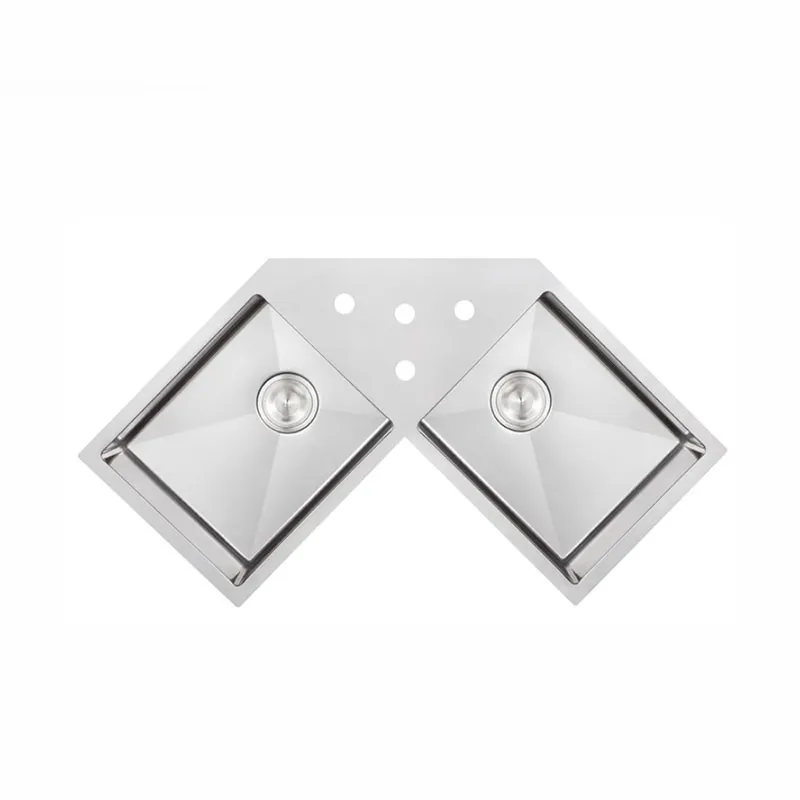Efficient space utilization is a constant theme in modern kitchen design. Especially for homes or apartments with relatively limited kitchen space, maximizing every inch becomes a crucial consideration during renovations.
In recent years, corner kitchen sinks, as a unique design solution, have become a popular choice for many home kitchens thanks to their flexible installation and space-saving advantages. So, do corner kitchen sinks actually save space? What are their advantages? And what specific space-saving benefits can they offer for different kitchen layouts?
This article will explore corner kitchen sink design concepts, space-saving principles, practical applications, and suitable kitchen layouts to help readers better understand how corner kitchen sinks can help achieve efficient kitchen space utilization.

What is a corner kitchen sink?
A corner kitchen sink is a sink installed in the corner of a kitchen. Unlike traditional sink layouts, corner sinks are typically designed with a diagonal shape, adapting to difficult-to-use corners in L-, U-, or G-shaped kitchen layouts. Corner kitchen sinks are often more compact than conventional sinks and maximize space efficiency.
Corner sinks are often installed differently than traditional sinks. Designers will adapt the design to the kitchen's corner by creating a smooth transition between the sink's edge and the wall and countertop, optimizing the use of the corner.
What are the design advantages of a corner kitchen sink?
• Compactness and Flexibility: Corner sinks are typically compact, meeting common kitchen cleaning needs without taking up too much space. They are ideal for smaller kitchens or those with complex layouts.
• Saving Countertop Space: Corner sinks create a closer edge between the sink and the countertop, eliminating the space wasted by traditional sinks.
• Improving Space Utilization: In traditional kitchen designs, corners are often overlooked. Corner sinks can fully utilize this space, improving overall functionality and space efficiency.
How do corner kitchen sinks save space?
1. Utilizing the Corner
In traditional kitchen layouts, kitchen corners are often unused or underutilized areas. Installing a sink in a corner not only effectively utilizes this space but also consolidates kitchen work areas (such as washing and chopping), improving efficiency.
For L-, U-, or G-shaped kitchens, a corner sink transforms the countertop's corner into a usable sink area, making the entire kitchen work surface more flexible and avoiding the space waste associated with traditional sink installations. For example, in an L-shaped kitchen layout, the sink can be installed in the corner between two work areas, saving space while ensuring a smooth flow between the two areas.
2. Saving Countertop Space
Corner kitchen sinks are typically positioned parallel to the countertop, creating a seamless transition between the sink edge and the countertop, maximizing countertop space. Compared to traditional sinks that occupy a portion of the countertop, corner sinks utilize the corner location, freeing up more countertop space for other kitchen tasks. Sink design is particularly crucial in conserving countertop space in small or compact kitchens.
Corner sinks also provide a larger work surface or space for appliances and supplies, creating a more spacious kitchen area and avoiding wasted space. Corner sinks are ideal for families who frequently use countertop space for meal preparation or cleaning.
3. Increased Storage Space
Corner sinks also help increase kitchen storage space. Because sinks are often located in corners, designers often create cabinets or drawers around the sink. These cabinets and drawers are often compact and can be customized to fit the shape of the sink, maximizing storage space.
Many modern kitchen designs feature compartmentalized cabinets or drawers beneath corner sinks to store cleaning supplies, dishwasher accessories, trash cans, and other kitchen essentials. Since sinks are often installed in low cabinets, this design not only conceals plumbing and the sink, but also provides additional storage space.
4. Avoids Wasted Kitchen Aisle Space
Traditional sinks can intrude on kitchen aisles or create an awkward kitchen layout, especially in small kitchens. Corner sinks, on the other hand, allow the sink to be recessed into the kitchen corner, eliminating wasted aisle space and creating a more compact and streamlined kitchen layout. This design effectively utilizes every inch of kitchen space, reducing unnecessary wasted space.

Which kitchen layouts are suitable for corner sinks?
The corner sink design isn't suitable for all kitchen types. However, it's best suited for layouts with more corners and limited kitchen space. Here are some typical kitchen layouts:
1. L-Shaped Kitchen Layout
The L-shaped kitchen is one of the most common kitchen layouts, consisting of two walls forming an "L" shape. In this layout, a corner sink makes full use of the kitchen's corner space. By placing the sink in the corner, the two work areas in the kitchen are more effectively connected, increasing work space and improving efficiency.
2. U-Shaped Kitchen Layout
A U-shaped kitchen typically consists of three walls forming a U-shape. Because a U-shaped kitchen has more corner space, a corner sink is ideal for this layout. Installing the sink in a corner of a U-shaped kitchen not only optimizes space utilization but also streamlines kitchen workflow and avoids wasting valuable countertop space.
3. G-Shaped Kitchen Layout
A G-shaped kitchen layout typically features an extended area (usually an island) based on a U-shaped kitchen. For this type of kitchen layout, a corner sink effectively integrates the island and countertop space, making the entire kitchen more coordinated and efficient. Placing the sink in a corner not only saves space but also provides more working space in the island area.
4. Compact or Small Kitchens
Corner sinks are particularly important in compact or small kitchens. Due to limited space, traditional sinks often take up valuable countertop or storage space. Corner sinks, however, allow the sink to be installed in the corner of the kitchen, freeing up more countertop and storage space. This allows the kitchen to maintain an efficient workspace despite its smaller footprint.

What are the disadvantages of a corner kitchen sink?
While corner kitchen sinks offer significant advantages in terms of space utilization, they are not without their drawbacks. The following are some potential challenges with corner sinks:
1. Installation Complexity
Corner kitchen sinks are often more complex to install than traditional sinks. This is because they need to be precisely positioned in a corner, requiring careful angle measurement and plumbing layout. To ensure a secure installation and efficient use of space, a professional installation team is often required.
2. User Comfort
While corner sinks can save space, they can also be inconvenient. Because they are located in a corner, users may need to bend or reach, making operation more challenging. This can be particularly inconvenient for larger sinks, especially for taller users.
3. Maintenance Difficulty
Corner sinks can be difficult to maintain. Due to their relatively hidden location, cleaning and repairing the plumbing beneath the sink may require more space. This can increase the maintenance burden, especially if problems arise.
Therefore, corner kitchen sinks offer an effective solution for efficient space utilization in modern kitchen designs. By fully utilizing corner areas, they not only save countertop and storage space, but also improve overall kitchen efficiency. Especially suitable for L-shaped, U-shaped, G-shaped, and compact kitchens, the corner sink design maximizes kitchen space, making kitchen layouts more flexible and efficient.

What makes Higold’s Inox kitchen sinks stand out in the global market?
Our company integrates advanced manufacturing systems with digitalized factory management, ensuring consistent high-quality production. With over 500 patents and Red Dot awards, Higold delivers innovative handmade sinks using robotic welding, automated grinding, and PVD finishing technology.
Whether you’re looking for wholesale sinks at low prices or customized ODM solutions for your brand, Higold offers professional quotes, promotions, and high-quality supply from China.


